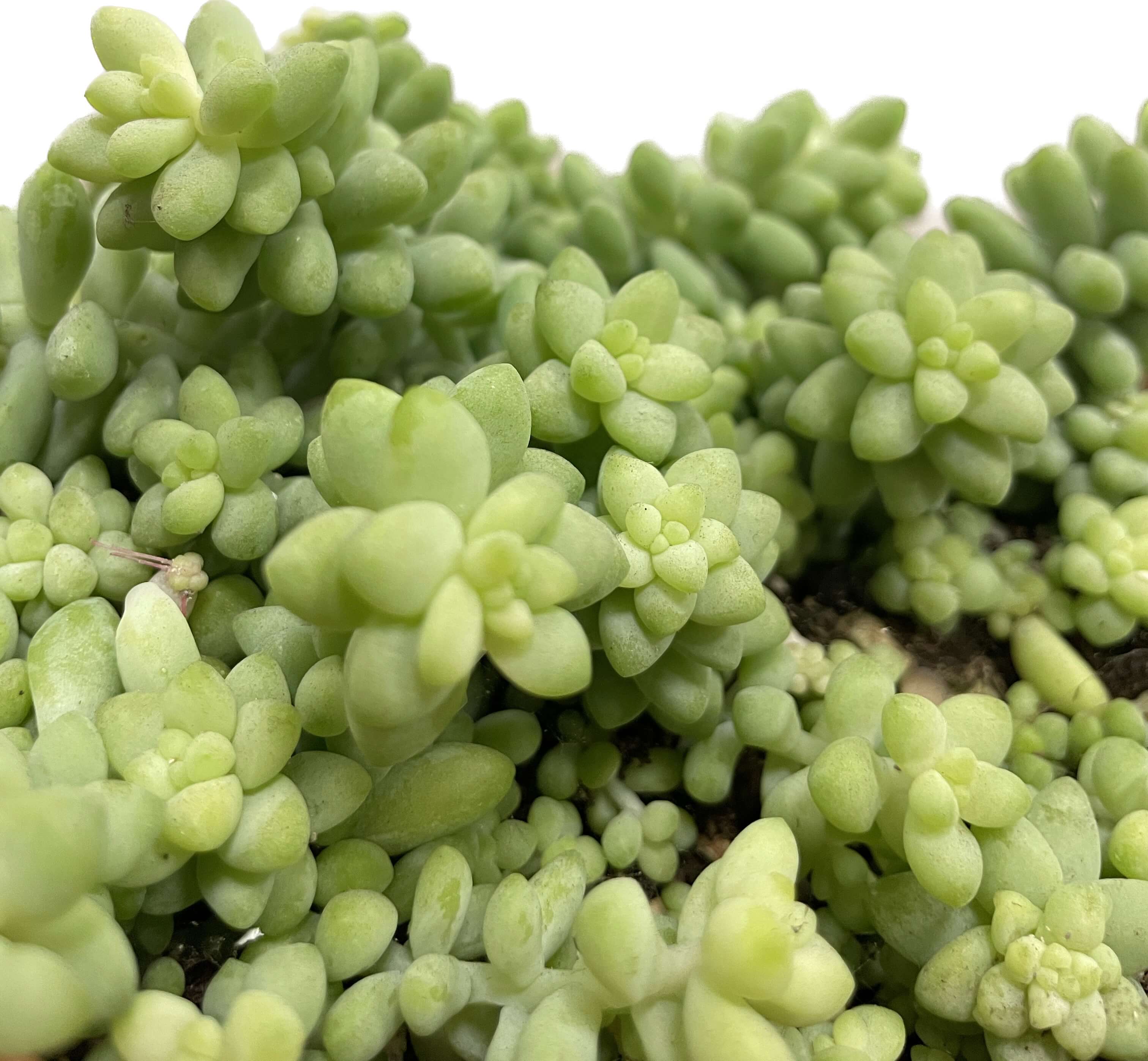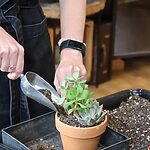Table of Content
- About
- Light
- Humidity
- Water
- Soil
- Pests & Disease
- Feed
- Pruning & Propagating
- Repotting
- Troubleshooting & Tips
- Species
- Sedum morganianum ‘Donkey Tail’
- Sedum Lineare Variegated
- Sedum morganianum ‘Burrito’ (Burro’s Tail’)
- Anacampseros Rufescens
About
Sedums, commonly known as stonecrop, come in a wide variety of forms, textures and colours, with approximately four to five hundred plants that make up the genus which all fall into the Crassulaceae family. The majority of these plants are naturally found around the Mediterranean in dry rocky areas where temperatures are high and rainfall is low. Some varieties have also been found in high-altitude regions of South America and across areas of North Africa.
Sedums are amongst the easiest plants to care for and are a strong option if you need a plant that can tolerate a touch of neglect. Ranging in colour, most sedums are bright and vibrant and can add a well-needed dash of colour with a range of vivid pinks, reds, yellows, and light blues. These fantastic little plants are often groundcover, mound forming, or trailing and are classed as succulents, storing water in their thick fleshy leaves, which is what makes them incredibly drought tolerant.
Light
Sedums like it bright! These plants thrive in high levels of ambient light but to perform at their best they will need to be exposed to some direct sunlight, at least two to four hours a day minimum. As houseplants, it’s best to give your plant direct sunlight in the morning or late afternoon. While these plants will tolerate high amounts of light most houseplant varieties will need to be gradually acclimatised to be able to tolerate more intense sunlight. Sedums are still sensitive to harsh midday sunlight and this can cause damage to their leaves and even send them into shock if they are suddenly placed into this type of environment.
Sedums are incredibly intolerant to low light conditions. Placed in an area where the plant will receive no direct sunlight and low low levels of ambient light they will soon start to suffer and begin to display signs of distress.
Humidity
Humidity levels are nothing you need to worry about with these plants. Their natural environments have allowed them to adapt and thrive in dry areas. Even with the heating on or when moisture levels in the air are non-existent Sedums will continue to do just fine.
Water
When it comes to watering Sedums the main thing to remember is, the more sunlight the plant is exposed to the more water it will require as it will dry out quicker. That being said, depending on the size of your plant they still don’t require a great deal.
But these plants are very susceptible to overwatering, it is crucial that you allow the plant to dry out completely before watering again. It’s important to remember that as a succulent, Sedums will store water in their leaves, they have adapted to do this to go long periods without water. So if the plant is saturated with water and not allowed to dry out before being watered again it quickly starts to turn yellow and drop leaves.
During the winter months, Sedums become dormant and will require almost no water at all during this period. The occasional drop is needed if the soil has completely turned to dust otherwise it’s best to leave them alone. During the winter months, Sedums become dormant and will require almost no water at all during this period. The occasional drop is needed if the soil has completely turned to dust otherwise it’s best to leave them alone.
Soil
Sedums can happily survive in very nutrient-low soil, their ideal conditions will be kept in soil that has a neutral to slightly alkaline pH. The most crucial aspect of the soil is that it MUST have excellent drainage, these plants will not tolerate water hanging around their root system.
The easiest option is to use specific cacti and succulent compost this should provide adequate drainage and the right amounts of nutrients. Other good potting mixes you could use can be made up of; 3 parts potting soil, 2 parts coarse horticultural sand, and 1.5 parts of perlite.
Pests & Disease
Sedums are susceptible to mealybugs and aphids when kept as houseplants. It is good practice to regularly check your plants for any signs of aphids, red spider mites, mealybugs, and thrips. By checking regularly, you allow yourself time to prevent a full-blown attack.
The most common pests Sedums tend to suffer from are mealybugs. This will normally occur from a lack of airflow. If you can increase airflow the pests tend to subside but will need to be treated to fully get rid of the issue.
But the number one killer of these plants is root rot from overwatering which can cause your plant to quickly decline followed by complete collapse.

Check our video on homemade pest remedies or head over and read are Fungus Gnat Fact Check and Home Remedies how to guide
Feed
Sedums require very little feeding and will often thrive better in low-nutrient soil. A good option would be to use specific cacti and succulent liquid feed only applied every six to eight weeks in the growing season. During the winter months, Sedums shouldn’t be fed at all. The easiest and most effective way to give your plant a boost of nutrients is to simply top-dress your plant with a thin layer of compost.
Pruning & Propagating
There is not much pruning to be done with a Sedum, it is more a plant you leave to just get on with it. It is a good idea to prune any failing, diseased or dying growth.
It’s important to note, you should never cut through the leaves of sedum and only remove them by cutting away from the stem. Cut leaves can leave them susceptible to infection and fungal disease.
Always use a clean and sterilised pair of scissors or secateurs to trim back!
Repotting
It’s best to repot your Sedum only when it’s root bound. Depending on the size of the plant, you may find yourself repotting every two to three years. They will happily stay root-bound and still maintain good health.
The pot size only wants to increase by a small margin as it’s easy for these plants to drown in pots that are slightly too big.
If you have reached your maximum pot size you will need to top-dress the plant once a year with a fresh layer of soil to replenish the nutrients.
The best time to repot your plant is when spring arrives and the plant is no longer dormant. Outside temperatures will rise and the daylight hours will increase. When this happens your Sedum will react quickly to the environmental change and start producing lots of new foliage growth.
You will need to pick a pot with excellent drainage, we don’t want water hanging around the roots.
Next, fill a third of the way up with your cacti potting mix and place the root ball of the plant in the centre of the pot.
Fill the pot with the rest of your potting mix and firm down the soil.
When you’ve finished and got your plant back in the perfect spot you can give it a thorough watering to settle the plant into its new pot. Keep a close eye on it for the first couple of weeks and then relax back into your normal watering and feeding schedule. Avoid feeding for the next 6 weeks as this influx of additional nutrients can cause damage to the root system and make it difficult for the plant to settle into its new environment.
Troubleshooting & Tips
- Sedums can suffer from sunburn and shock if placed in direct sunlight for long periods without having time to adapt
- A red tinge will also appear on the leaves if they are exposed to too much sunlight.
- If the leaves of your plant have become mushy and starting to drop off this is an early indicator that the plant has been overwatered.
- Sedums respond well to pinching out the growing tips, this will encourage growth and create a bushier plant.
- If the potting soil is high in nutrients this can cause leggy growth and this is often when plants start becoming overly top-heavy.
Species

Sedum morganianum ‘Donkey Tail’
Also known as ‘Donkey’s Tail’ this fantastic sedum is a real eye-catcher. This beautiful trailing succulent produces loose clusters of slightly elongated arched leaves from stems that form long, thick trailing chains with fleshy light green leaves and subtle hints of blue. Perfect to use as a hanging plant, in a raised plant stand, or anywhere it’s allowed to hang down



Sedum Lineare Variegated
This compact variety of sedum is a low-growing variety and given enough space this plant will want to form ground-covering mounds. Producing unusual foliage of pale green leaves with thin, snow-dusted, cream-white edges. This delicate and dainty plant would sit gorgeously on a desk or bright window sill.


Sedum morganianum ‘Burrito’ (Burro’s Tail’)
Very similar to Sedum ‘Donkey Tail’’ but with subtle differences, the easiest way to tell them apart is from the difference in leaf shape. Burros have tighter clusters of rounded leaves and a darker green complexion. Forming long trailing stems that can grow up to 60cm that produces stunning pink/red flowers in mid-summer. This tough-ever-green succulent is a gorgeous addition to any home and really needs to be seen in person to be appreciated.




Anacampseros Rufescens
Commonly known as the ‘Sunrise Succulent’ this small featured slow-growing plant is a sight to behold. A bright and colourful variety of sedum this plant produces small fleshy ovate leaves that go through an almost rainbow spectrum of colours, starting out a light green before slowly transitioning to a bright rich purple/pink with the colour gradually getting darker as the plant matures.















